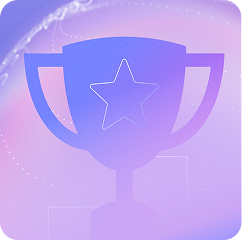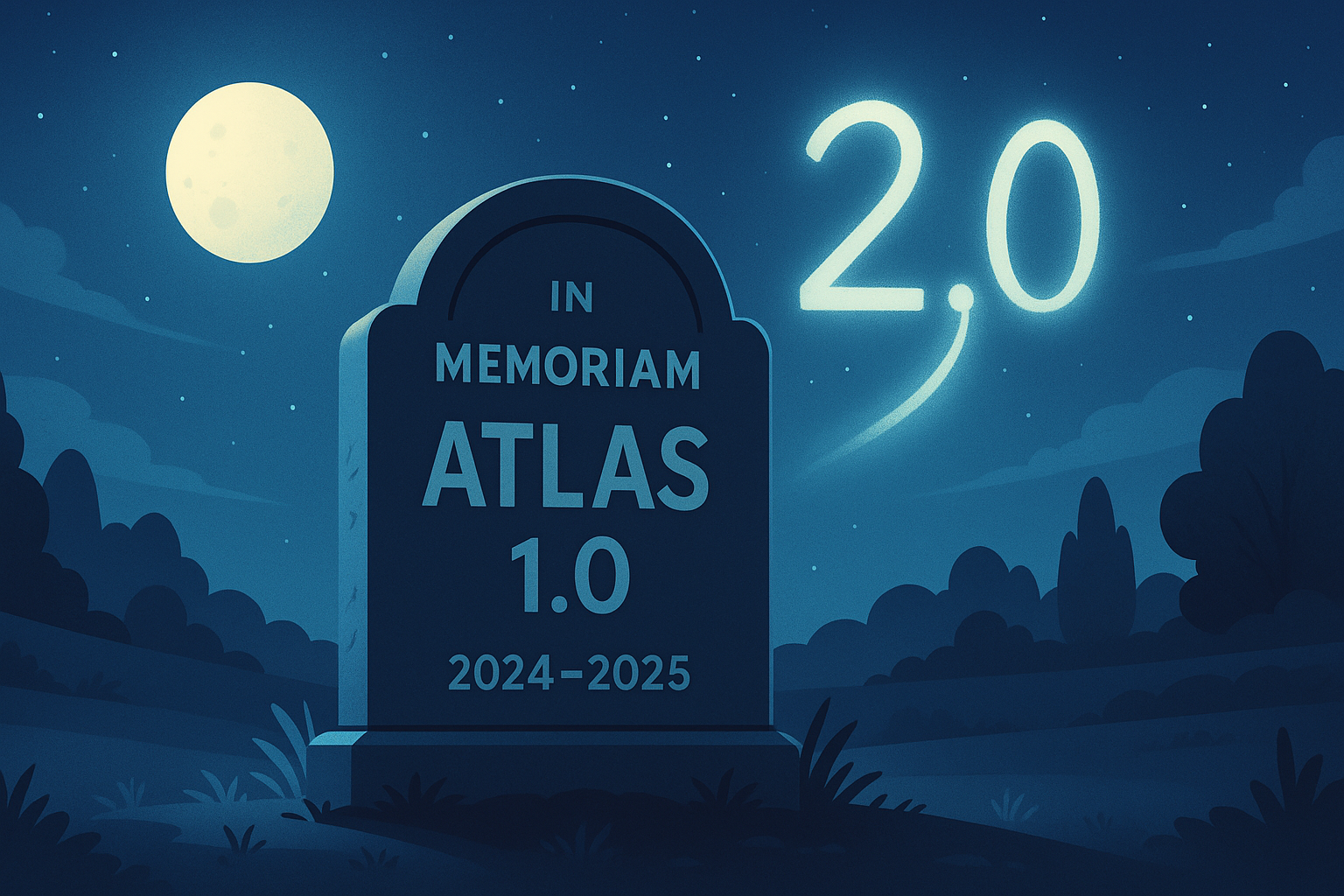
// Atlas Technology
The Recruiter’s Guide to Migrating Data to Atlas (With Screenshots)
20/02/2025
14 MIN
You dislike your CRM but data migration is also a hassle. You don’t have to play coy with us.
And, you aren’t alone either. A recent survey from Resco showed only 37% of CRM users were very satisfied. Let’s face it, when was the last time you spoke to a friend in recruitment about how amazing their CRM was?
But you haven’t migrated your CRM. Why?
Because the data migration is DAUNTING and you are running a recruitment business. The CRM may suck but it keeps the lights on. You’ve heard nightmares about botched CRM migrations and you don’t want to go through that nightmare yourself.
The downside. You don’t get to use AI. Not really. That clunky, non-AI CRM may be easy to stick with but so was shuffling chairs on the Titanic.
AI hasn’t just made CRMs much, much better. It’s made CRM migrations much more straightforward. So sit back, grab a knob of butter to slather over this dry-toast content and let’s put your mind at ease.
What is data migration?
Data migration is transferring information from a legacy system to a modern recruitment software solution. In recruitment, the core data revolves around people, companies and jobs but there can be a lot more to it. Custom attributes, financials, contractor books, and notes all need to come with.
Every recruitment software has a data model which is a glorified collection of spreadsheets which hold everything from education all the way through to resume files.
However, legacy systems have old, inflexible data models that prevent them from offering new features to their clients.
Therefore a data migration involves moving the data from one data model to another.
What are the 3 key steps of data migration?
The data migration process typically involves three key phases:
Plan: The planning phase is crucial for the success of the entire data migration process. It involves assessing and cleaning the source data, analyzing business requirements and dependencies, developing and testing migration scenarios, and creating a formal data migration plan.
Execute: During the execution phase, the migration solution is implemented, and the actual data transfer takes place. This phase can be stressful, especially for stakeholders directly impacted by the migration.
Verify: The verification phase involves validating the migrated data and decommissioning the old systems. Data validation testing is conducted to ensure that all required data has been transferred accurately and that the values in the destination tables are correct.
How does data migration work with Atlas?
Step 1: Collecting your data
The first step involves receiving your data from the legacy application’s source database that you’ve used until now. Sometimes this will be a database file (BAK for instance) but sometimes it can be a collection of CSV files.
As these are large source clusters and data files, the legacy provider will usually provide you with FTP credentials which will comprise a username, password, FTP address and port number.
You don’t need to worry about understanding that, just give us the details and we can secure your data.
Receiving your database files
Once you’ve requested the export, your old provider will usually deliver the database as CSV files or a full backup file. Sometimes it’s a direct download link, sometimes it comes via FTP access — either way, we’ve seen it all.
Importantly, this step should always be free once your account is settled. If you’re being charged despite clearing your invoices, give us a shout — we’ll help you sort it out.
Step 2: Mounting the database
Once we’ve secured your data export, the next move is to mount that data into a live, queryable environment. For this, we use Amazon Redshift — a high-performance data warehouse that allows our engineers to inspect, filter, and prepare your information for transformation.
Think of it like unpacking moving boxes in a clean, well-lit room. No more zip files or cryptic folder names — just raw, structured tables we can actually work with.
Here’s an example of what your data looks like at this stage: a live table tracking candidate experiences. It includes timestamps for when each record was created or updated, the source of the data (resume, manual entry, or synced via CES), and of course, details like company name and job title.
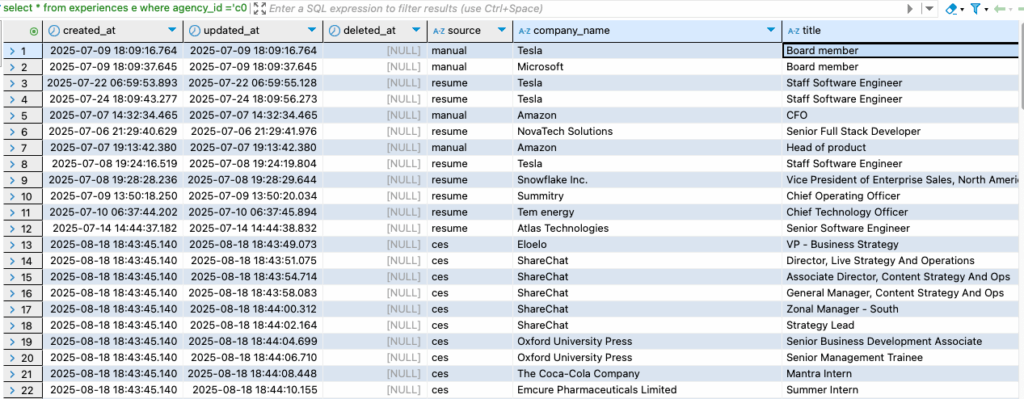
This is what’s underneath all those polished user interfaces — just structured data, clean and ready to be shaped into something more usable.
Why does this matter? Before we can begin transforming your data into Atlas’s format and cluster configuration, we need to understand how your legacy system stored it. That means validating what fields are present, where the inconsistencies lie, and how to ensure we carry across every important detail — without the clutter.
By working in Redshift, we’re able to move quickly and confidently into the transformation phase, with full visibility into your data at every step.
Step 3: Mapping your data in the Atlas dashboard
Now that your data lives in a live, queryable environment, it’s time to give it structure.
You’ll log in to our Migration Dashboard — a purpose-built tool where you can preview your data, configure mappings, and track progress. At this stage, we’ll work together to align your legacy fields (like “First Name,” “Engagement Type,” or “Candidate Status”) with Atlas’s data model.
This part isn’t about guesswork. You’ll get a clear spreadsheet showing how your data currently looks, along with recommended field mappings. From there, you can review, adjust, and confirm. Our team will guide you through anything unfamiliar — from mapping obscure tags to cleaning up inconsistent status values.
Here’s what that process looks like in action:
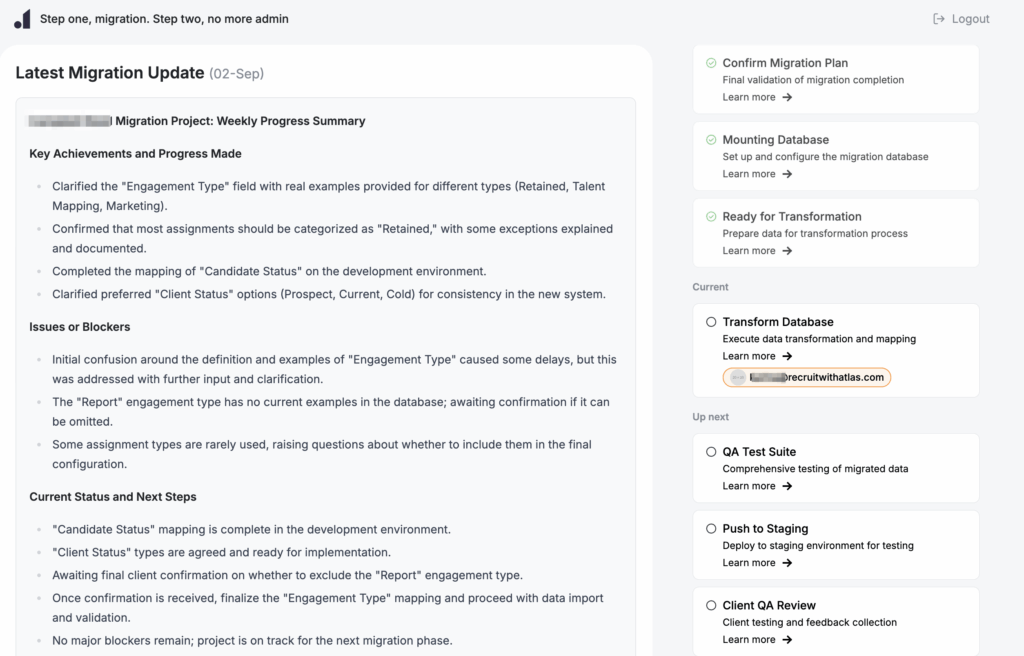
Each update is tracked in a weekly progress summary, so you always know what’s been completed, what’s outstanding, and what’s coming next. If there’s ever ambiguity (like whether “Report” should be a real engagement type), we flag it, document it, and wait for your go-ahead.
No technical jargon required. Just clear decisions backed by support and real-time visibility.
Step 4: Transforming your data
Once your data is mounted and mapped, we begin reshaping it to fit the Atlas live migration service data model. Think of your legacy system as a messy Excel workbook — technically functional, but inconsistent, cluttered, and difficult to scale. Our goal is to translate that into something clean, structured, and ready for modern recruitment workflows.
We use DBT (Data Build Tool) to handle this step. It’s a SQL-based framework that lets us define transformation logic in code, test it, and version it — so your migration is repeatable and reliable.
Here’s what that looks like behind the scenes:
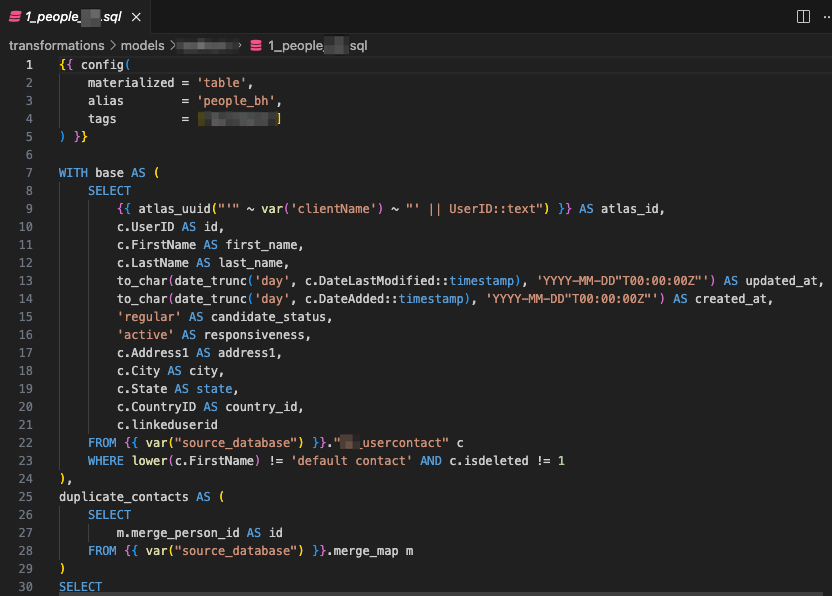
This script transforms a set of core person records: assigning new IDs, standardizing names and timestamps, and applying default candidate statuses and responsiveness levels. You’ll notice fields like first_name, last_name, and address1 being pulled in and restructured to match Atlas’s schema.
We also use AI automation to help accelerate the more repetitive tasks — things like detecting duplicated records, cleaning up inconsistent formats, and filling in common gaps. It’s not a black box — every step is visible and testable.
This transformation step usually takes 2–3 days, depending on the complexity of your original system and the number of custom fields involved. Our team flags anything unusual along the way (e.g. overlapping IDs or ambiguous mappings), so we can resolve it quickly with you.
By the end of this phase, your data is no longer just extracted — it’s Atlas-ready.
Step 5: Quality assurance (QA) & migration status testing
Before your data goes anywhere near production, it has to pass a gauntlet of quality assurance checks. Think of this as the final filter built for testing purposes that catches anything weird, broken, or missing.
We run 30 to 40 automated tests per table — yes, per table — covering everything from required field validation to duplicate detection and data type mismatches. That usually adds up to 300 to 400 tests in total, and the results come back in minutes, not days.
Here’s what that looks like in real life:
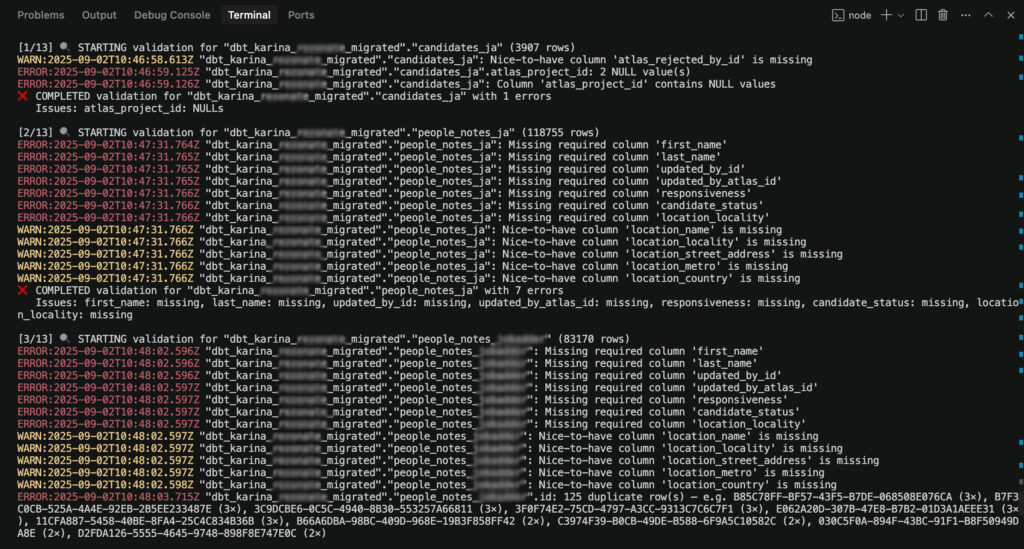
Each test checks specific criteria. Did every first_name field make it through? Are there NULL values in columns that should always be populated? Are there duplicate UserIDs we need to merge or clean?
These aren’t just “nice-to-haves.” Fields like responsiveness, candidate_status, and updated_by_id are essential to how Atlas works. If anything’s missing, it’s flagged — and we fix it before moving on.
We also use generative AI to scan for anomalies across the dataset: things that technically pass validation but don’t look right — like 100 records all added at 4:00 am, or two candidates with the same name, email, and experience history.
Only once every critical test is green do we proceed to the final load.
Step 6: Live migration staging environment
Once your data has passed QA, we deploy it into a staging environment — a safe, sandboxed version of Atlas that looks and behaves just like the real platform.
This is where you come in.
You’ll receive a detailed migration checklist that guides you through key validation steps. It’s not just “does the data look right?” — we show you exactly what to look for:
- Are merged profiles from your old system showing up as expected?
- Do contact methods like email and LinkedIn URLs match what was in your previous CRM?
- Are company names, websites, and job titles intact?
Here’s what part of that checklist looks like in action:
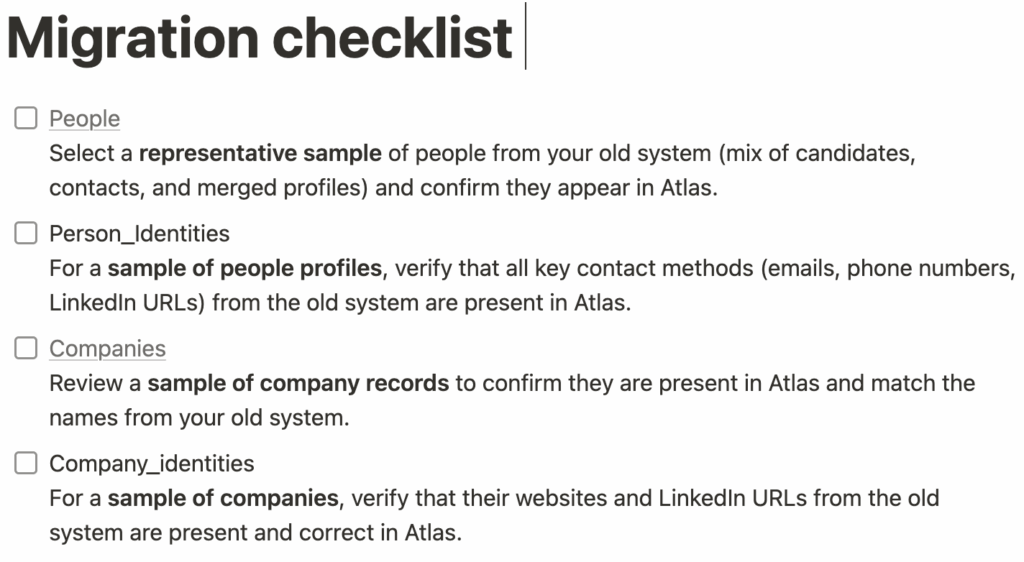
You don’t need to be technical to use it — we include examples for each check so you can confidently verify everything, even if this is your first time migrating data to Atlas.
We also keep the feedback loop tight. You’ll collaborate with our team via Notion, where all migration tasks, comments, and updates are tracked. And to save you from digging through threads, our dashboard uses AI summaries to give you a daily digest of what’s done, what’s pending, and what needs your input.
This step moves as fast as you do. Once everything is confirmed in staging, we prep for the final move to production.
Step 7: Product migration
Once you’ve signed off on staging, we move to the final step: pushing your data into production Atlas — the real deal.
If your team is already using Atlas, the newly migrated data is carefully merged with your existing records. We ensure there’s no duplication, no overwrites, and no confusion. Every new record is matched, mapped, and integrated without disrupting your current workflow.
If you’re brand new and ready to configure Atlas from scratch, your staging data becomes your clean production baseline — polished, validated, and ready to go.
At this point, your migration is complete. No more parallel systems. No more uncertainty. You’re officially up and running on Atlas with your data right where it belongs.
Step 8: Indexing for search
After migration, we make sure your loaded data isn’t just in Atlas — it’s searchable.
Atlas uses Elasticsearch for fast, powerful search across candidates, jobs, companies, and more. As soon as your data hits production, we run a full index so everything is ready to search on day one.
Whether you’re looking for a candidate you placed in 2021 or filtering for “Java Developers in Manchester,” Atlas delivers results instantly.
Step 9: File migration
The final step is moving your candidate and company files, including CVs, contracts, presentations, and other attachments, into Atlas.
We make sure every file is linked to the correct record so nothing gets lost or orphaned. Whether it was uploaded last week or five years ago, it’ll be right where you expect it.
Step 10: Migration complete
At this stage, everything is in place:
- Your historical data is live in Atlas.
- Your files are linked to the right records.
- Your data is fully indexed and searchable.
- And your team can get straight to work — no downtime, no disruption.
Welcome to faster, smarter recruitment.
In short: Our migration process combines enterprise-grade infrastructure, automation, and AI-driven QA with a hands-on human team. The result is a smooth, transparent migration that gets you set up on Atlas with confidence.
What about our operations during data migration?
Beyond the technical aspects, successful data migration also involves managing business continuity. Recruitment agencies cannot afford downtime during the migration. Atlas’s approach includes:
Parallel operations: Running the old and new systems simultaneously for a short period.
User training: Providing training sessions and documentation to ensure a smooth transition.
Cutover planning: Scheduling migrations over weekends to minimize disruption.
What are the challenges of data migration?
Data migration is not without its challenges, which can impact the success of the project. Understanding and addressing these challenges can improve the likelihood of a successful migration.
Data quality issues
Poor data quality, such as inaccurate, incomplete, or outdated records, can result in errors and inconsistencies in the target system. Common issues include:
Duplicate records: Leading to inefficiencies and miscommunication.
Missing fields: Causing gaps in candidate profiles or job postings.
Inconsistent formats: Making it difficult to standardize data across multiple sources.
Addressing these issues requires thorough data cleansing and validation before migration.
Data consistency issues
Inconsistent data formats or structures can complicate the integration process. For example, if one system uses “MM/DD/YYYY” for dates while another uses “DD/MM/YYYY,” it can create alignment challenges. To overcome this:
Standardise formats: Ensure all data adheres to a unified format, such as ISO 8601.
Harmonise structures: Map data fields from the old system to the new system’s schema.
Data security issues
Sensitive information, including candidate and client data, must be protected during migration. Common risks include:
Unauthorised access: Exposing data to external threats.
Data breaches: Compromising confidential information.
Atlas employs strict data encryption protocols and ensures compliance with GDPR and other data protection regulations to safeguard sensitive information.
Data integration issues
Integrating data from multiple sources can lead to inconsistencies if not managed correctly. Challenges include:
Mismatched data models: Older systems may use different naming conventions and structures.
Custom attributes: Unique business-specific fields need to be identified and mapped correctly.
To address these challenges, Atlas provides tools for custom field mapping and data validation during transformation.
Other migration challenges
Scalability issues
Ensuring the system can handle large datasets without performance degradation is a critical aspect of data migration. Recruitment agencies often manage database connections containing thousands of candidates, job postings, and historical records. Challenges related to scalability include:
Performance bottlenecks: Large-scale data transfers can slow down the system, especially if the
infrastructure is not optimised.Resource allocation: Insufficient server resources or bandwidth can lead to delays in the migration process.
Database optimisation: Older systems may not be designed to handle the load of modern applications, necessitating adjustments during the migration.
Atlas addresses scalability by leveraging cloud-based infrastructure such as Amazon RDS and Redshift, ensuring efficient handling of large datasets. Automated scaling and load balancing further optimize the process.
Time constraints
Completing the migration within tight timelines is another significant challenge, particularly for businesses that rely on their recruitment software for daily operations. Common issues include:
Downtime risks: Prolonged migrations can disrupt business activities.
Coordination delays: Synchronising teams, resources, and data can be time-consuming.
Unexpected issues: Errors during transformation or loading can extend timelines.
Atlas mitigates time constraints by employing:
Pre-Migration planning: Detailed roadmaps outlining every step of the migration.
Automated processes: Tools like DBT Labs reduce manual intervention, speeding up data transformation.
Weekend cutovers: Scheduling migrations over weekends to minimise operational disruptions.
By addressing these challenges proactively, Atlas ensures that recruitment agencies can meet tight deadlines without compromising data integrity or business continuity.
Data migration strategies
Data migration can be approached in several ways, each with its own set of advantages and challenges:
Big Bang approach: This strategy involves migrating all data at once. While it can be less costly and less complex, it carries a high risk of failure, which can be expensive to rectify.
Phased approach: In this approach, data is migrated in stages. It is less prone to unexpected failures but can be more expensive and time-consuming.
Hybrid approach: Combining elements of both the big bang and phased approaches, the hybrid approach offers a balance between cost, complexity, and risk.
Incremental approach: This strategy involves migrating data in small increments. It is suitable for organisations with limited resources or tight deadlines, as it allows for gradual progress and easier management of potential issues.
What types of data migration are there?
Data migration can be categorised into several types, each serving a unique purpose:
Business process migration: This type focuses on transferring databases and applications related to customers, products, and operations. It is often driven by mergers and acquisitions, business optimization, or reorganisation efforts to address competitive challenges or enter new markets.
Storage migration: This involves moving data from one storage device to another. It is often undertaken to upgrade to faster, more efficient storage solutions or to consolidate storage resources.
Database migration: This type involves transferring data from one database to another. It can be particularly complex if the source and target databases have different data structures or formats.
Application migration: This process entails moving a software application from one computing environment to another. Challenges arise when the old and new infrastructures have distinct data models and work with different data formats.
Cloud migration: This involves moving data, applications, or other elements to a cloud computing environment. Organisations often choose cloud migration to reduce costs and enhance scalability.
Frequently asked questions (FAQs) on migrating to Atlas
Most full migrations are completed within 5–10 business days, depending on the size and complexity of your database. We typically schedule final cutovers over a weekend, so your team is ready to go on Monday with zero downtime.
Yes. Whether you’re using Bullhorn, Vincere, JobAdder, or something custom, we can handle it. Our team has experience working with a wide range of legacy systems and ensures your data maps cleanly so that Atlas supports it fully.
No. Our process includes detailed mapping, QA testing, and staging verification to ensure that every candidate, note, tag, and attachment is preserved when migrating your data to Atlas.
That’s exactly what we’re built for. Our tools clean, deduplicate, and reformat your data so you start fresh in Atlas. Even if your legacy system is full of inconsistencies, we’ll help you migrate clean, usable data.
YYes. We run migrations in parallel with your current system and work around your schedule to ensure near continuous uptime on both systems. You can keep recruiting while we prepare your data — and once it’s ready, we cut over with minimal disruption.
Why choose Atlas for your data migration?
✅ Minimal downtime: Our process ensures your recruitment team keeps working with zero disruption.
✅ Data accuracy: We handle everything, ensuring no duplicate records, missing fields, or lost resumes.
✅ Custom mapping: Your unique custom fields and workflows are preserved.
✅ Fast and efficient: A full migration typically takes a weekend, so you start fresh on Monday.
✅ Dedicated support: Our expert team is with you at every step.
Ready to migrate your data to Atlas?
Migrating your data to Atlas doesn’t have to be risky or painful. With the right tools, a proven process, and hands-on support, you can move your entire recruitment operation to a modern, AI-powered platform — without the headaches.
Whether you’re moving from Bullhorn, Vincere, or a homegrown system, Atlas gives you clean data, fast search, and zero disruption. Ready to leave legacy systems behind? Let’s make your next migration your last.


